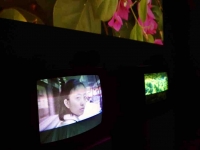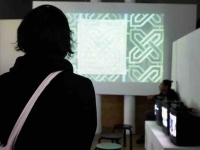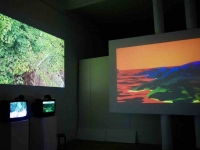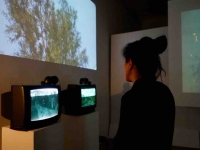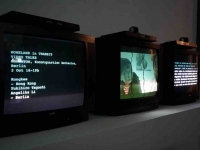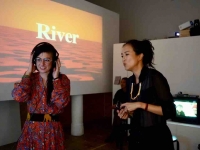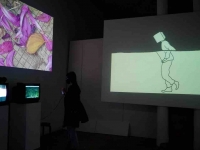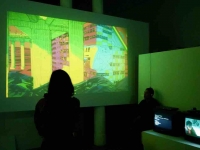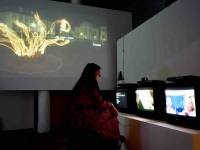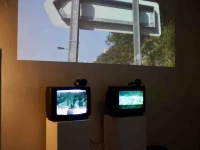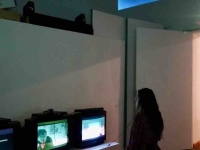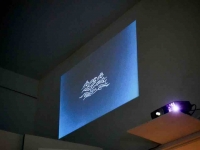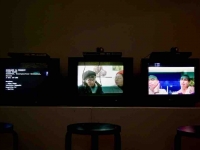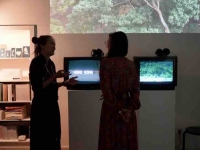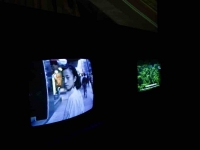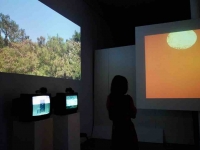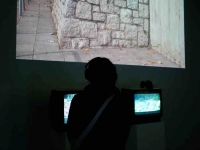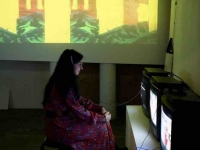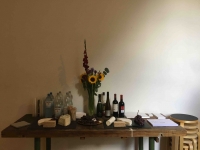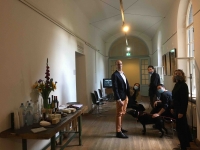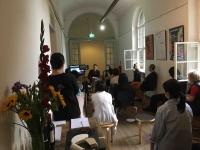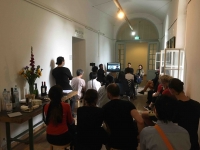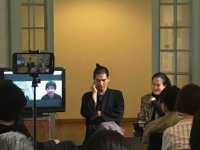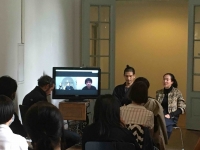MOMENTUM and
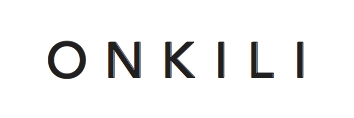
co-present:
HOMELAND in TRANSIT
EXHIBITION:
1 October – 29 November 2020
1 October – 1 November 2020: Wednesday – Sunday 1-7pm
2 – 29 November 2020: Due to the November Lockdown, we are open only by appointment on info@momentumworldwide.org
VIDEO TALKS:
3 October at 4 – 7pm
Angelika Li moderates Kongkee in Discussion with Yukihiro Taguchi
Curated by Angelika Li
Featuring:
May FUNG // Kongkee // LAW Yuk Mui // LEUNG Chi Wo // MAP Office // Yukihiro TAGUCHI
@ MOMENTUM
Kunstquartier Bethanien
Mariannenplatz 2, 10997 Berlin
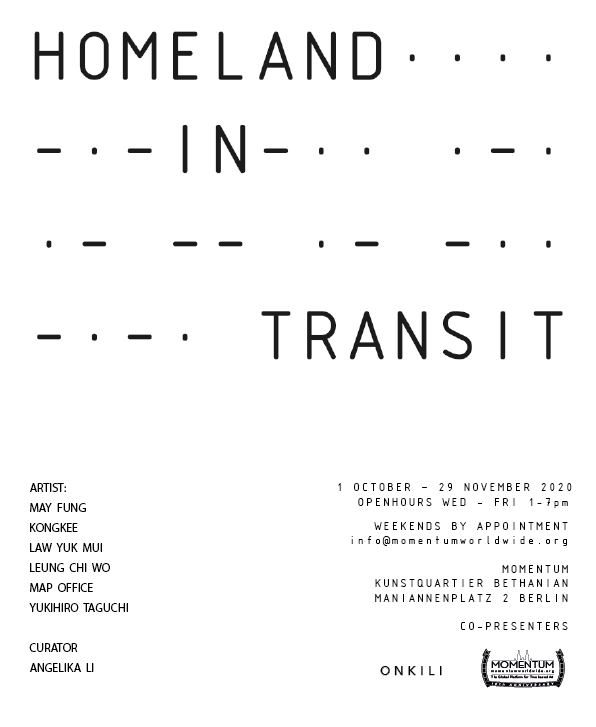
Curatorial Statement
The word ‘homeland’ evokes a physical and permanent form on the surface, yet when we dive a little deeper into our memories and emotions, the word urges us to reflect on its complex and shifting nature. The inaugural exhibition of HOMELAND in TRANSIT in 2019 channeled narratives of ‘homeland’ from Hong Kong perspectives: the floating islands, borders and boundaries, unfolding histories of diaspora, the metamorphosis of cultural identity, colonial ideology and beyond.
Despite many differences in our backgrounds, the sense of homeland is constantly being questioned and reinterpreted. How do artists perceive these transformations and how do they represent it in their art?
In only a few months, our world has changed dramatically and each word in this title has developed a wider scope of meanings and expanded relevance: we feel an urgent need to further communicate and encourage more exchanges and discussions. The HOMELAND in TRANSIT VIDEO TALKS, which were launched in Basel in February 2020, continue the exchange and lead to this exhibition taking place at MOMENTUM, with time-based works by 7 artists from Hong Kong and a Berlin-based Japanese artist exploring the notions of migration, self-searching, cultural identity, memory, and our resilience as humans. Water – as an intrinsic and characteristic element of Hong Kong – occupies a strong presence.
Visit Chapter Two of HOMELAND in TRANSIT Here > >
 |
May Fung
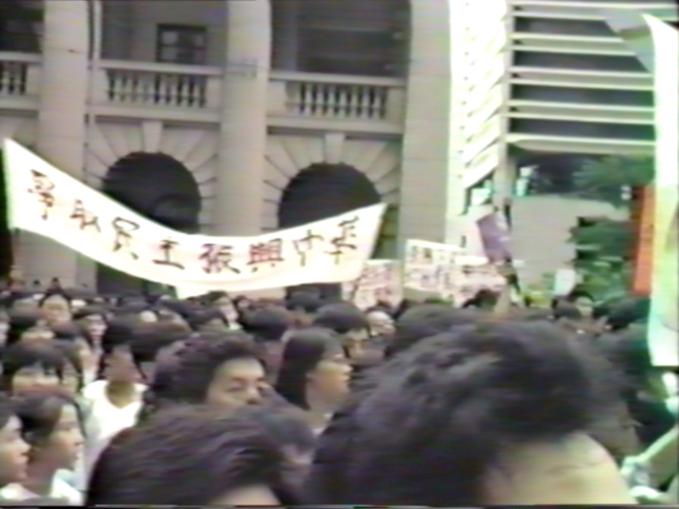
Image of a City, 1990, Video, 11 min
With the rapid urbanisation of Hong Kong since the 1970s and an influx of migrants from China, how do Hongkongers perceive the changes of their city and their cultural identity? May Fung is one of the most influential video artists at the forefront of experimental practice in Hong Kong for over three decades. Her work often interweaves local history, cultural landscapes, politics and poetics. Her two works Image of a City (1990) and She Said Why Me (1989) offer images of Hong Kong through a time tunnel from the 1967 Hong Kong riots to the 1989 Tiananmen Square protests, with footage drawn from the Hong Kong Government Record Service. Through cityscapes marked with architectural references that reflect the parallel worlds of both Chinese and British, the artist channels her emotions and memories along the pivotal transformations and negotiations between the two cultural worlds coexisting in one city. The anxiety and frustration expressed in the works have become self-fulfilling prophecies. What the footage depicts keeps resurfacing through our timeline, as seen in the recent movements in Hong Kong and other parts of the world.
Recordings of scholar Ackbar Abbas’ lecture on the notion of ‘culture in a space of disappearance’ guides us through Image of a City (1990): “Hong Kong…has never seized being a port, a door, a threshold, a passageway. It is a space in transit. Everything is provisional, temporary and ad hoc.” Overlapping the voice of Abbas in the video is Margaret Thatcher’s speech on ‘one country, two systems’. Abbas described Hong Kong as “not so much a place as a space of transit,” whose residents consider themselves as transients and migrants on their way from China to the next place. What is disappearing? Is it something visible or intangible? Is it our heritage and identity, or our sense of belonging? Is it the memory of our past, or our imagination of the future?
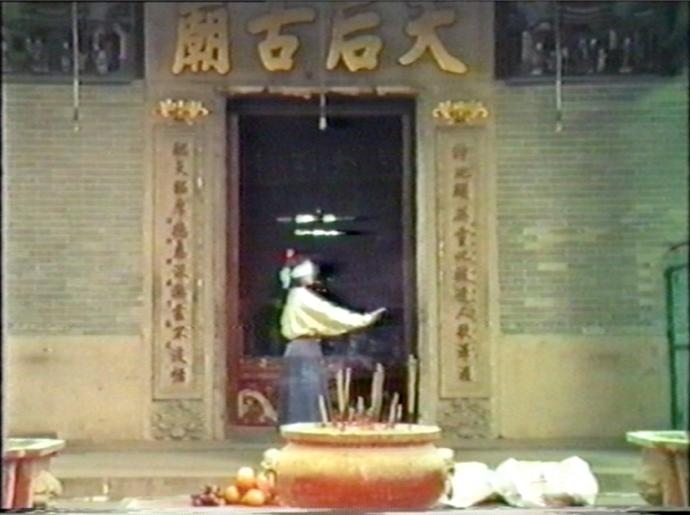
She Said Why Me, 1989, Video, 8 min
May Fung’s narratives of disappearance and cityscapes linger with a strong sense of frustration and self-searching in She Said Why Me (1989), in which a blindfolded female protagonist starts her journey from a Tin Hau temple where traditionally fishermen in Hong Kong worship and pray to the deities for protection in the waters. The artist uses the temple as a form of attachment to her heritage. Interwoven with historical footage of focusing on women as objects of surveillance, the protagonist transits into the modern cityscape of the Hong Kong district Central, finding her way among the monuments which represent the colonial era. At one point, she loses her blindfold yet she still moves like a sleep-walker. When she comes to realise her blindfold is no longer there, she starts running aimlessly, but from what and where to? Seemingly lost, with a sense of displacement and despair, the woman acts as the artist’s outlet of emotions through this process of self-searching, venting her frustrations about her gender, cultural identity, the transformation of the city. At the pivotal junction on Queen’s Road Central, she turns and stares back sharply at the camera with anger and fear: ‘Why me?’ She then finds her way, though blindfolded, back to where she came from. That leads us back to the sea, the notion of water.
May Fung (b. Hong Kong 1952, lives and works in Hong Kong) is one of the most influential video artists at the forefront of experimental practice for over three decades in Hong Kong. Her work often interweaves local history, cultural landscapes and politics. Fung is one of the founders of Videotage, a Hong Kong collective promoting experimental video and new media art and the founder of Arts and Culture Outreach, a cultural organisation that has transformed the Foo Tak Building on Hennessy Road into a vertical arts village with artist studios, a bookstore and a rooftop garden. Fung is also an active arts educator, filmmaker, curator and art critic. Her recent exhibition includes Five Artists: Sites Encountered (M+ Museum, Hong Kong, 2019).
Kongkee
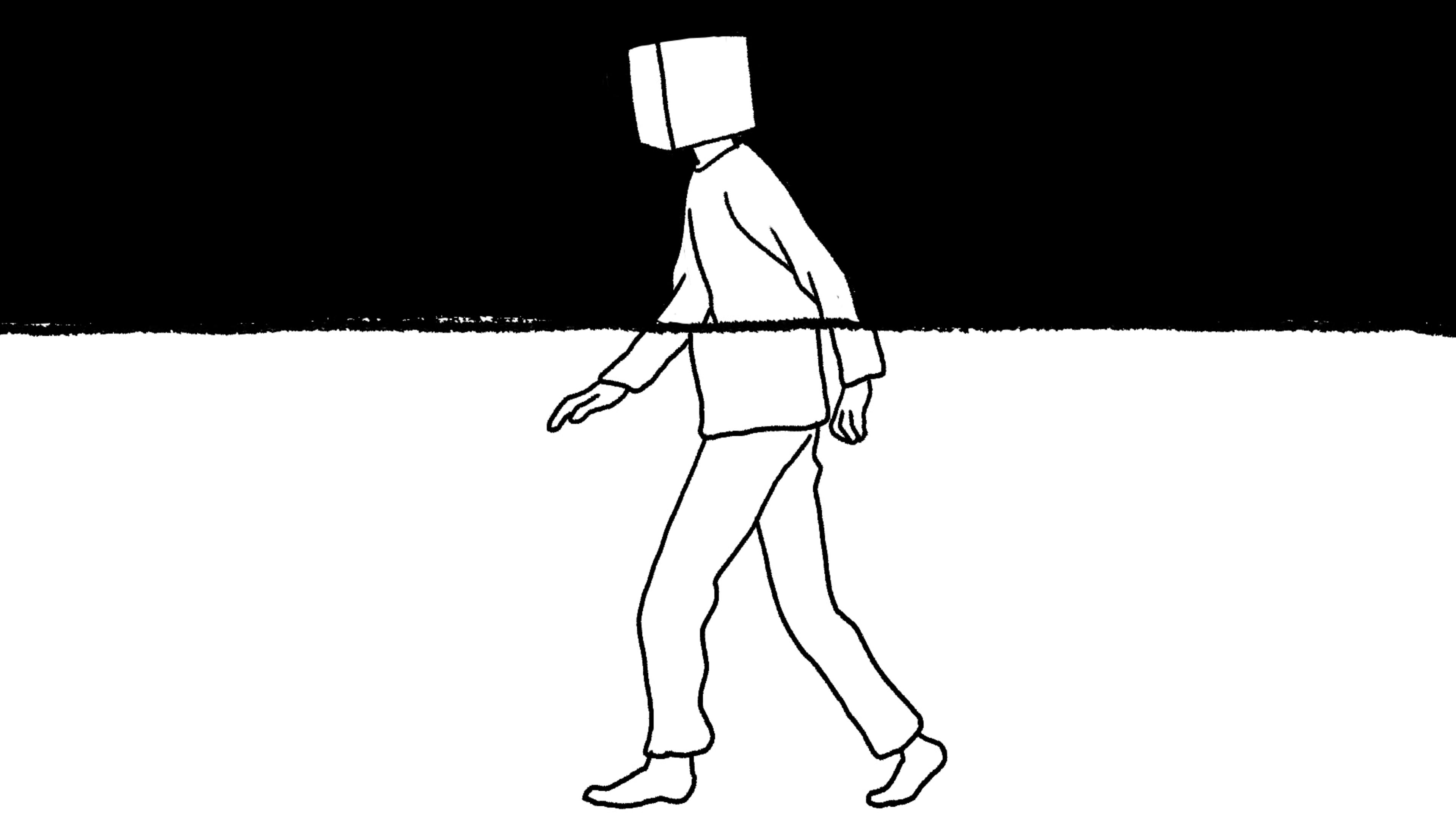
I Can’t Find Myself, Most of The Time, 2020, Animation, 1 min 56 sec
Greek philosopher Heraclitus had a famous analogy about life: “You cannot step twice into the same river”, which recalls the Chinese philosophy of change in the Yijing (I-Ching or Book of Changes): the only certainty is change, as such each moment is unique. Kongkees latest animations, created in 2020, are anchored by these concepts. Time cannot travel backward, everything is always in a state of becoming. During the process of making animation, with the help of software and tools, characters can flow fluidly back and forth in time, as though existing beyond time itself. Travelling between dimensions, pasts and futures and grabbing hold of the most precious moments; however, the ending has always already been drawn out for the animation characters. In “reality” we are unable to see the future and there is no way of reading the script of our lives. We are part of the current of time. There is a feeling that our destiny, unfinished, is still to be written.
Both videos shown here are silent, focusing the viewers on the movements and visual expressions of the artist. Kongkee uses I can’t find myself, most of the time (2020) as a mouthpiece to project his state of mind. The motion and gestures of the walking man are those of a sleepwalker or someone in a state of dreaming. To the artist, dreaming also feels like walking through water. The walking man has a strong sense of direction but where is he heading? Could it be read as an analogy of the discoordination between the mind and body, consciousness and physical strength? In the water and above the surface, time is lapsing between the two realms. The work becomes a meditation for the artist to release his emotions from what can perhaps be felt – distress and powerlessness. Like a self-reflection, with his head being trapped in a box through the complex process of thinking, he does not seem to be able to escape from the situation.
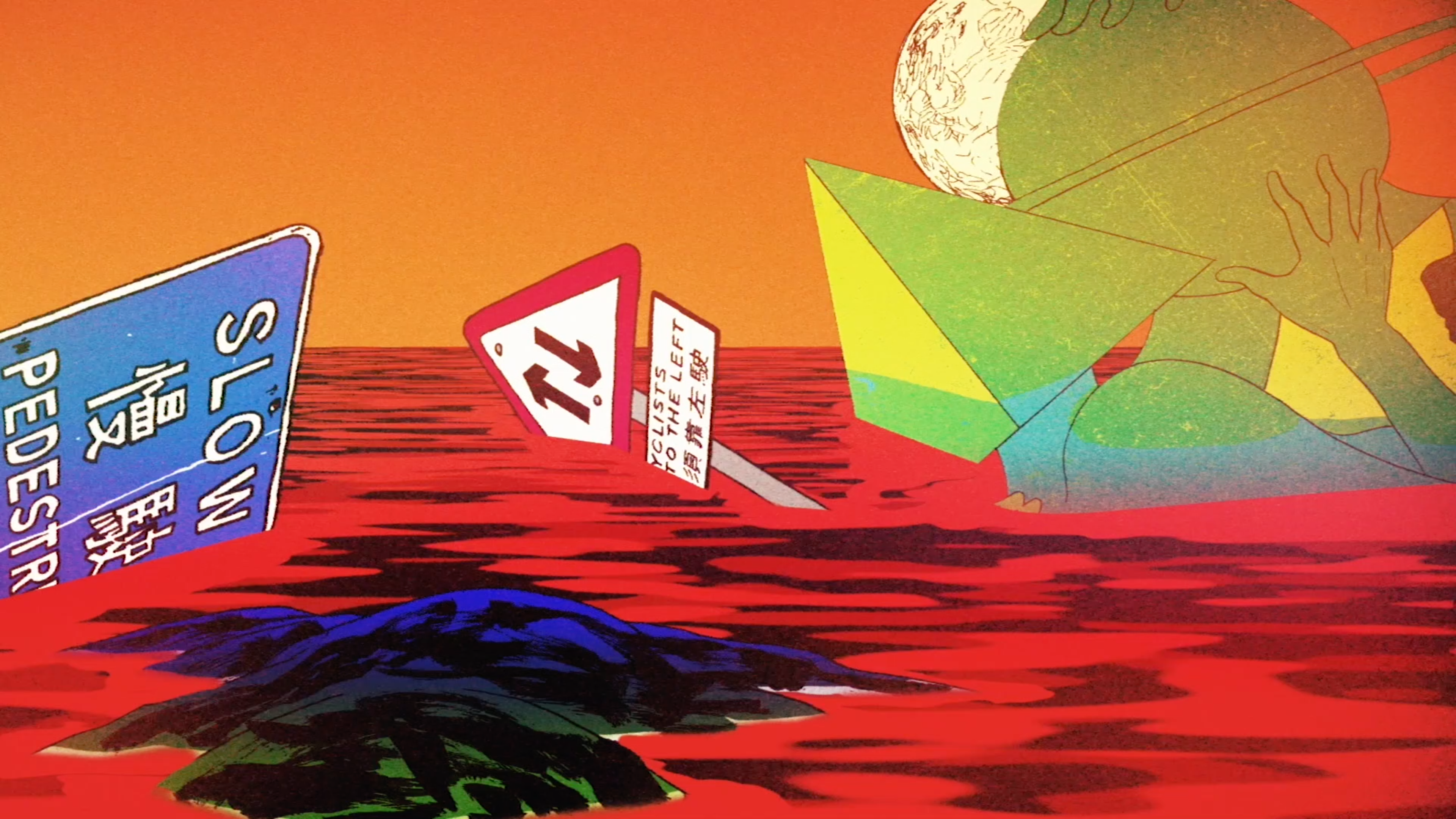
River, 2020, Animation, 5 min 3 sec
In Kongkee’s River (2020) the familiar daily objects in Hong Kong are floating in the same direction as in I can’t find myself. The colours are vibrant yet the manifestation of the beaten, powerless or lifeless objects evoke fear, melancholia and darkness. What are their stories? Where are they going? Fear often comes from the unknown, uncertainty and instability. Based on the artist’s sensitivity in terms of challenging global situations, people are getting closer and building solidarity, exporting and importing ideas. Along this line of thought, the idea that construction is built on destruction is once again obvious. In reality, we are quite uncertain as to what is coming in the future and can we really write the script and storyboard of our lives like in an animation? In the artist’s words: “there is a feeling that our destiny, unfinished, is still to be written.” One might easily be drowned in this melancholic blackhole of current affairs and situations in her or his homeland. Humans are resilient. By going forward, one shall see hope. In the darkest hour, the slightest ray of light will illuminate the darkness and show us the way.
Kongkee (b. Malaysia 1977, lives and works in Hong Kong) is an animation director and comic artist who is inspired by his city Hong Kong as a natural subject as seen in his comic book Travel to Hong Kong with Blur for his collaboration with the British band BLUR’s album The Magic Whip in 2015. Kongkee’s ‘Comics Detournements: La literature de Hong Kong en bande dessinée’ (co. Chihoi) gained international acclaim in the literary arts communities. In 2017, his comic and co-directed animation short Departure received the Japan TBS channel “DigiCon6 Asia Gold Mention”. In 2018, Kongkee launched a feature-length animation project Dragon’s Delusion with a Kickstarter campaign. He was a member of the jury for the International Competition of the Internationales Trickfilm-Festival, Stuttgart, 2019. The artist graduated from the Fine Arts Department, The Chinese University of Hong Kong in 2000. He received his MFA Creative Media from City University of Hong Kong in 2005.
Law Yuk Mui
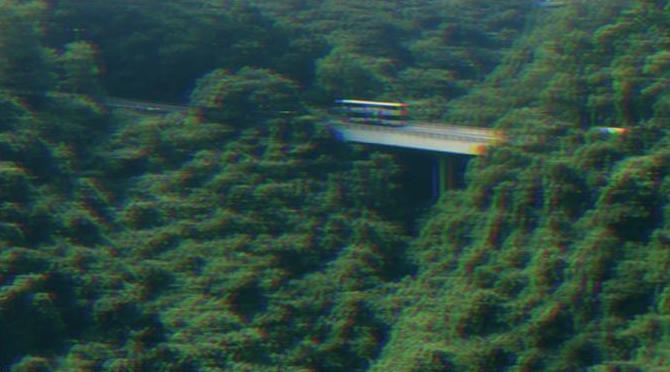
On Junk Bay, The Plant, 1990-present, Video, 2 min 56 sec, with Cyanotype of plants
Law Yuk Mui’s On Junk Bay, The Plant (1990-present) leads us to revisit the geographical history and metamorphosis of Junk Bay, later known as Tseung Kwan O (TKO), an area of reclaimed land in Hong Kong where the artist used to live. The earliest inhabitants of the area can be traced back to the 13th Century, and major settlements date back to the late 16th Century when small fishing villages were formed in the area. With its geographical advantage on the opposite side of Hong Kong’s Victoria Harbour, shipping industries emerged in Junk Bay the 1960s until 1982 when the local government began the development of TKO as a new town which saw a chain of major reclamation constructions. Notably, the government never uses the old name ‘Junk Bay’.
Law Yuk Mui’s lens not only captures the natural landscape of the area but also the history of its phenomenal land development through reclamation where foreign plants migrated, were transplanted and re-rooted. Through her investigation of Hong Kong cartography and passion in geology, the narratives delve deeper into the contemplation of migration, native vs foreign, borders and the relationship, and negotiation between human and nature.
Law Yuk Mui usies plants as metaphors, where foreign plants are like migrants and refugees transplanted to a new land – as in her parents’ migration from China to Hong Kong. As the speed in Hong Kong is always so fast, the artist strategically paces the video in slow motion to prolong 15 seconds of real life to create time to engage the audience with her subject matter. The distorted sound is excerpted from Hayao Miyazaki’s animation ‘Castle in the Sky’ with its tree trunks growing into the sky offering a sense of future and hope.
Using image, sound and installation as her mediums of preference, and adopting the methodology of field study and collecting, Law Yuk Mui often intervenes in the mundane space and daily life of the city and catches the physical traces of history, psychological pathways of people, the marks of time and political power in relation to geographic space. Law often digs beyond the surface, through which she recovers fragments of narratives and micro histories.
Law Yuk Mui (b. Hong Kong 1982, lives and works in Hong Kong) have been extensively exhibited in Asia, including: Michikusa, Art Tower Mito, Japan (2020); Jogja Biennale (2019); From Whence the Waves Came, Para Site (2018); Art Basel Hong Kong (2018); Future Life Handbook, Redtory Museum of Contemporary Art, Guangzhou, China (2017-2018); Victoria East: FUSE Artist Residency, Videotage, Hong Kong (2017); Talkover/Handover 2.0, 1a space, Hong Kong (2017); Busan International Short Film Festival, South Korea (2017).
Law Yuk-mui received The Award for Young Artist (Media Art Category) from the Hong Kong Arts Development and the Excellence Award (Media Art Category) of The 23rd ifva Awards in 2018. Law graduated from The Chinese University of Hong Kong with a Master of Fine Arts (MFA). She is the co-founder of the artist-run organisation Rooftop Institute in Hong Kong.
Leung Chi Wo

My Name is Victoria, 2008, Video, 21 min 30 sec
The notion of memory is highlighted in the historic and colonial narratives in Leung Chi Wo’s video ‘My name is Victoria’ (2008). Leung’s practice primarily draws from references and archives with history as a subject matter. He often digs up small details and reveals unknown facts. Eleven years after Hong Kong’s sovereignty changed hands from Britain to China in 1997, the artist created this work in 2008 to explore the perception and interpretation of the name ‘Victoria’. This video work unveils an unfamiliar route in the city: starting from Victoria Road in Kennedy Town, the border of Victoria which was the former capital of the crown colony, to Aberdeen where the British, under the reign of Queen Victoria, landed for the first time in Hong Kong in 1841. Through an open call on the internet, the artist collected forty women’s stories about their name ‘Victoria’, which are narrated by a single female voice in a distinctive soft British accent with music by Franz Schubert playing in the background.
The light-hearted atmosphere in the video juxtaposes the heavy cultural and political issues the work is concerned with. The name ‘Victoria’ carries a majestic air and represents a time in the past in the context of Hong Kong. In these stories, one notices how different generations think about naming, and the artist’s curiosity on how a name is reinterpreted over time and across cultural beliefs. Once a foreign name is transplanted, new meanings are born. Leung brings up these multiple layers of naming with irony and wit. The proper phonetic tranliteration for Victoria in Cantonese is ‘Wai Dor Lei Nga’ which connotes a majestic and elegant air. But it is commonly written as ‘Wik Dor Lei’ literally meaning ‘Region of Profit’ which reflects certain local values and also contradicts or even ridicules the regal background of the name. How does history and the knowledge of history shape our perception and self-recognition?
Leung Chi Wo (b. Hong Kong 1968, works and lives in Hong Kong) is a visual artist whose reflective practice combines historical exploration with conceptual inquiry within a contemporary urban landscape. Ranging from photography, video, text, performance to installation, he is concerned with the undetermined relationship between conception, perception, and understanding, especially in relation to site and history within cultural/political frameworks. He was featured in the first Hong Kong pavilion at the Venice Biennale in 2001 and has exhibited in major international institutions including Tate Modern in London, NRW Forum in Dusseldorf, Museu da Imagem e do Som in São Paulo, The International Studio & Curatorial Program, and Queens Museum in New York. Selected solo exhibitions include Something There and Never There, Blindspot Gallery, Hong Kong, 2018; This Is My Song, Rokeby, London, 2016; Tracing some places, The Mills Gallery, Hong Kong, 2015; and Press the Button… OCT Contemporary Art Terminal, Shenzhen, 2015. His work is extensively represented in public collections such as M+ Museum, Hong Kong, Hong Kong Heritage Museum, Hong Kong Museum of Art, Hong Kong Legislative Council, and Kadist Art Foundation, Paris/San Francisco. Leung has been visiting artist at Institut Kunst of Hochschule Luzern; Ecole Cantonale d’Art du Valais; Monash University, Melbourne; and Australian National University. He has participated in artist-in-residence programs in New York, Banff, Vienna, and Sapporo. He is co-founder of Para/Site Art Space and is an Associate Professor in the School of Creative Media, the City University of Hong Kong since 2010.
MAP Office
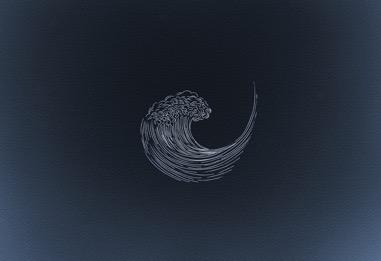
MAP Office’s ‘The Book of Waves’ (2018) brings to mind the often forgotten natural geography of Hong Kong, which consists of more than 260 individual islands, though it is better known as a densely populated modern cityscape. Engulfed in the sound of waves recorded from Hong Kong’s Shek O Beach and Big Wave Bay, MAP Office’s video animation of 250 hand-drawn waves and ripples in the nihonga style takes as its starting point the ‘Ha Bun Shu’ of Mori Yuzan, an archive of waves drawn from the Edo period. To achieve the quality of an animation, the artist duo had to imagine what the missing links of waves would be in order to weave the stories together. The traditional technique of handwork merges with new technology through the form of animation. MAP Office construct their own representation of the oceans around the world, which is the core of their current research.
MAP Office (Laurent Gutierrez, b. Casablanca 1966 and Valérie Portefaix, b. Saint-Étienne 1969, both live and work in Hong Kong) is a multidisciplinary platform devised by Gutierrez and Portefaix. This duo of artists has been based in Hong Kong since 1996, working on physical and imaginary territories using varied means of expression. MAP Office projects have been shown in over 100 exhibitions at venues including the MoMA and the Guggenheim Museum (New York), the Georges Pompidou Centre (Paris) and the Ullens Centre for Contemporary Art (Beijing), around 35 Biennales and Trienniales around the world with five contributions to the Venice Biennale in Art and Architecture (2000, 2003, 2007, 2008, 2010). Their cross-disciplinary practice has been the subject of a monograph, MAP OFFICE – Where the Map is the Territory (2011). MAP Office received the Sovereign Asian Art Prize in 2013. Their recent research projects have a strong focus on the ocean and have been shown internationally, including The Story of Amanami, Triennale di Milano 2019; Ghost Island. inaugural Thailand Biennale 2018; Islands, Constellations and Galapagos, Yokohama Biennale 2017; Desert Islands, Singapore Biennale 2016. Their work has been collected internationally by private and private institutions including M+ Museum, Hong Kong; FRAC / Institut d’Art Contemporain (IAC), Villeurbanne, France; Ullens Center for Contemporary Art (UCCA), Beijing, China; Deutsche Bank Collection, Hong Kong; Momentum Collection, Berlin; MIACA, Tokyo.
Not only does this work reflect the ocean condition, it also metaphorically represents the life of our city as ups and downs, calm and unsettling, in between the foreseeable and unpredictable. The water element recalls the controversial theory by French scientist Jacques Benveniste that water retains its own memory. If these are all true, can we presume that water also carries evidence of our history?
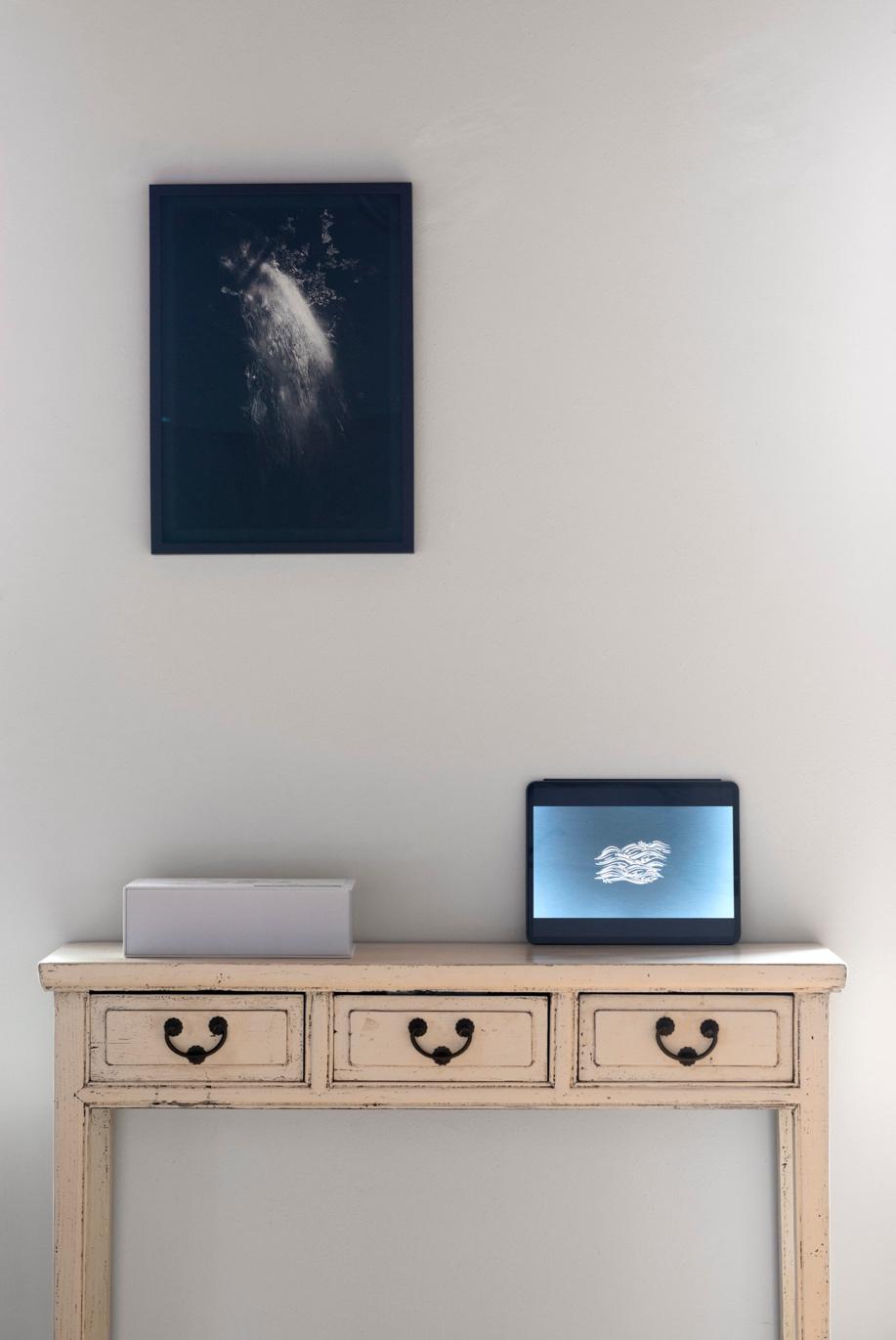
The Book of Waves, 2018, Animation, 2 min
250 hand drawings on computer screen inspired by Ha Bun Shu by Mori Yuzan, 1917
Sound recorded around Shek O Headland, 2018
Inkjet print on 160gsm Japanese Art Paper
Paper: 27 x 16.2 cm; Box: 28.4 x 17.6 cm
Yukihiro Taguchi
Magu (2012) is a stop-motion animation set in Male, Maldives, by Yukihiro Taguchi, dealing with the objects and memories of a place of transit. Male, the capital of the island country Maldives, is a famous transit hotspot for tourists travelling to the other islands. The majority of its inhabitants consist of locals and migrants. Roaming around the island, the artist encounters the colourful island fabrics, rhizomic and absorbing imprints from daily elements of the vibrant island life and the local environment – wall textures, manhole covers, iron grills and street signs. These fabrics become records of memories and spirits of the place and people. During Taguchi’s stay, he learns from the locals that certain colours represent particular cultural, political or religious ideals and identities, and some colours should be avoided. Colours signify different cultural, social and political meanings in every culture.
Terasu is a Japanese word meaning ‘to illuminate’. In his eponymous video, Taguchi contemplates the notion of darkness and light. Invited to create a site-specific project in Arnsberg, Germany, during the winter, the artist asked himself what would the strategy be when the sky goes dark so early? Taguchi applies his survival instinct, using fire he creates by the most primitive method of hand drilling. The artist draws with the fire across the town in lines and signs, creating soul-like energies, like a magic touch harmonising the contradictory yin and yang, using fire to draw a boat and a waterscape. At the end, the fire is transferred onto torches, and the people from the town draw the signs that represent themselves and their place. These are records of the collective memories and solidarity of people.
Berlin-based Japanese artist Yukihiro Taguchi (b. Osaka 1980, lives and works in Berlin) is known for his unique performative installations and community-based projects which are composed of drawing, performance, animation, and installation. The environment and the interaction with its people are his main source of inspiration from which he interweaves the local stories, traditions, and cultures together to explore spatial experiences, energies, and values in our urban landscapes. Taguchi’s recent exhibitions include Discovery in Kanaiwa, 21st Century Museum of Contemporary Art Kanazawa, Japan (2019); Echigo Tsumari Art Triennale, Niigata, Japan (2018); Open ART Biennale 2017, Örebro, Sweden; Project Patch Pass at MILL6 Foundation (2016); and Yukihiro Taguchi, Kunstverein Arnsberg, Germany. The artist graduated from Tokyo National University of Fine Arts and Music, Painting Department (B.A. in oil painting) in 2004.
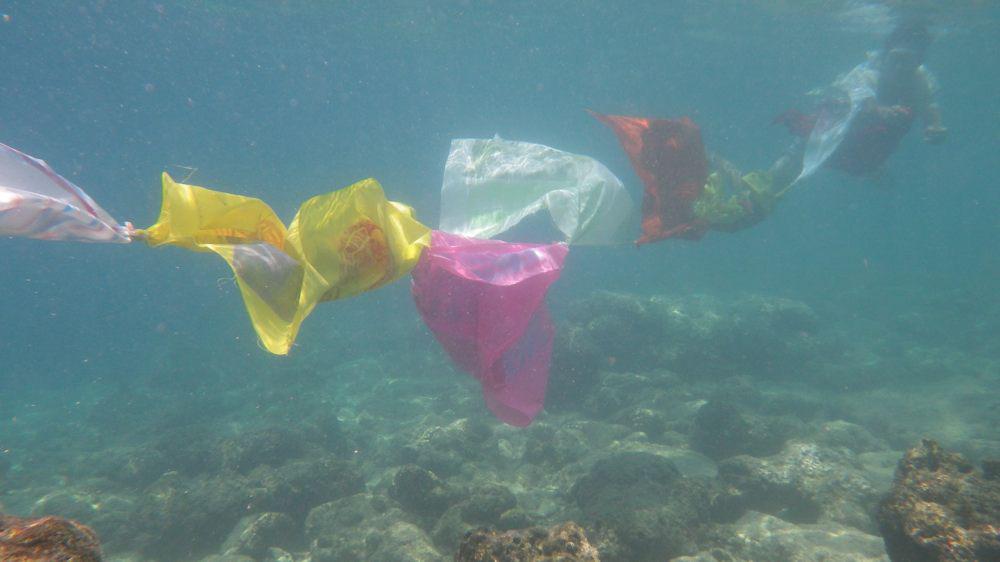
Magu, 2012, Stop-Motion Video, 4 min 49 sec
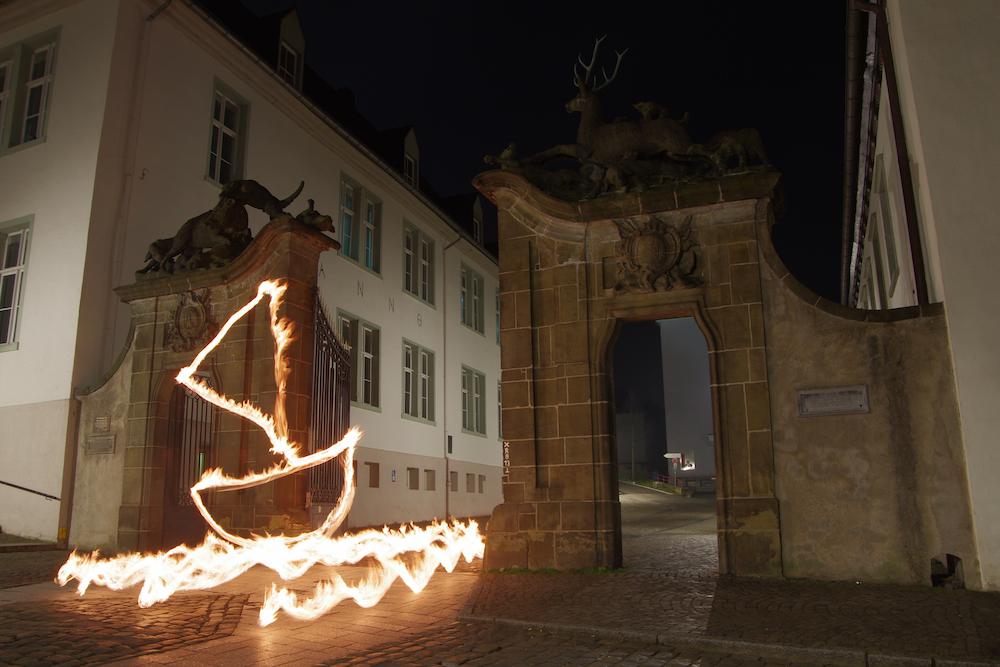
Terasu, Stop-Motion Video, 4 min 44 sec
Hope is not a form of guarantee, it’s a form of energy, and very frequently that energy is strongest in circumstances that are very dark. – John Berger
HOMELAND in TRANSIT Video Talks
Video Talks: LEUNG Chi Wo & Valerie Portefaix/MAP Office in dialogue with Angelika Li
Video Talks: May Fung & Law Yuk Mui in conversation with Angelika Li
Video Talks: Kongkee & Yukihiro Taguchi in conversation with Angelika Li
Curator Bio
With expertise and experience in the history of art and architecture as well as cultural management, Angelika Li is committed to engaging with the essence of local culture, heritage and valued stories, and driving a continuous dialogue between local and international communities. Li is the founder of the curatorial project HOMELAND in TRANSIT and is the co-founder of PF25 cultural projects, a research initiative focusing on the everyday life and ecologies of Switzerland and Hong Kong. In 2015, Li was the founding director of MILL6 Foundation bringing it to ICOM museum status and the Award for Arts Promotion by Hong Kong Arts Development Council in 2016.
Her previous projects include Tracing some places. Leung Chi Wo (2015); Textile Thinking – The International Symposium at Hangzhou Triennial of Fiber Art 2016 co- organised with Zhejiang Art Museum; Social Fabric. New works by Kwan Cheung Chi and Mariana Hahn in collaboration with curator David Elliott (2016), Old Master Q: What The @#$% Is Going On? Original Works by Alphonso Wong (2014); Beyond the Paper Screen – An Exhibition of Japanese Erotic Prints from The Uragami Collection (2013) and NEW INK: an exhibition of ink art by post 1970 artists from The Yiqingzhai Collection (2013).
HOMELAND in TRANSIT Logo Design Concept
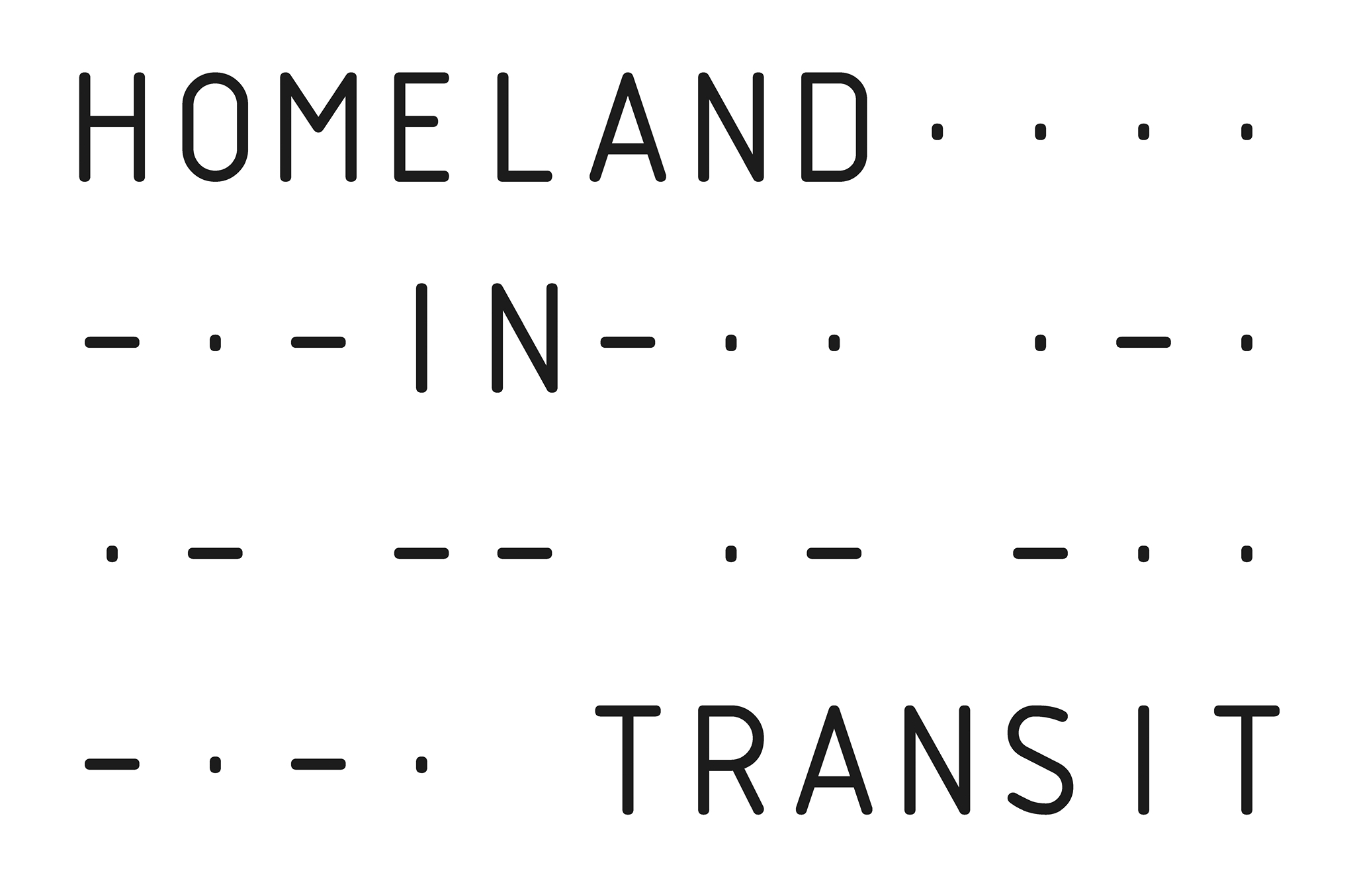
The Homeland in Transit identity is a neutral alphanumeric typeface with monospace structure mixed with Morse code. Based on the everyday elements we encounter on journeys and travels – train station and airport display boards, baggage tags, boarding passes, electronic tickets – the layout is a mix of simple information presented to be universally and easily understood with incomprehensible codes and symbols applied for professional or technical purposes. Letters, numbers, dots and dashes flow erratically to fill whatever area it needs to cover.
Designed by Donald Mak


 Back to Homepage
Back to Homepage